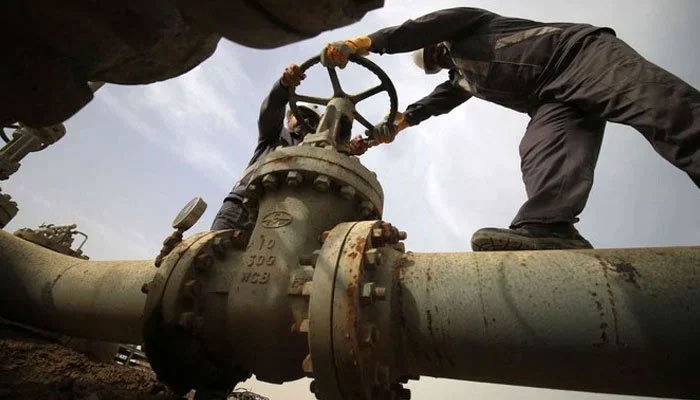Gas crunch puts Pakistan’s urea production, crop output at risk
Pakistan's agriculture sector is facing a looming crisis as the country struggles to meet the demand for urea fertilizer, a key input for crop production, amid a severe shortage of natural gas, industry official said
LAHORE: Pakistan's agriculture sector is facing a looming crisis as the country struggles to meet the demand for urea fertilizer, a key input for crop production, amid a severe shortage of natural gas, industry official said.
The fertilizer review committee (FRC), a body that monitors the availability and prices of fertilizers, warned in its recent meeting that the country could face shortfall of urea in the ongoing Kharif season, as well as the upcoming Rabi season.
The FRC attributed the urea shortage to the low domestic production capacity, which is hampered by the insufficient supply of natural gas to the fertilizer industry. Natural gas accounts for 70 to 80 percent of the cost of urea production.
"The writing is on the wall and the warning about persistent urea shortage has become more evident from the lingering issue stemming from paucity of natural gas, which is the main input for fertilizer industry," said one of the stakeholders who attended the FRC meeting.
At the crucial meeting held on Monday last, all provinces officially raised the issue of urea shortage. The price of urea, which was around Rs. 2,600 per 50-kilogram bag at the start of the Kharif season, now stands at about Rs. 3,000. However, it is difficult to obtain the farm input at the official price. Instead, the nutrient is being sold at up to Rs. 3,300 per bag in Punjab and Rs. 3,700 to Rs. 4,000 in Sindh and Balochistan. Farmers in Khyber Pakhtunkhwa have also complained about the urea price hike.
As per estimates, there will be a shortage of 0.2 to 0.6 million tonnes of urea by the end of the Rabi season of 2023-24. Manufacturing plants in Punjab used to face a shortfall of natural gas. However, now bigger plants in Sindh are dealing with low pressure and curtailed supplies, severely affecting the output of the essential farm nutrient.
Punjab’s projection for the ongoing Kharif season stands at 2.35 million tonnes for urea and 0.8 million tonnes for DAP. Punjab has to bear about 16 percent low urea availability in June. Overall, farmers in Punjab are getting 13 percent less urea in the current season.
The mandatory pairing of urea and DAP by dealers has led to low buying by farmers, as many cannot afford to buy costly DAP. This has also resulted in low urea off-take.
The tight supplies and price hike of urea did not turn into a full-blown crisis as the rainy weather rescued authorities by keeping demand for the chemical fertilizer low. Rain not only replenishes moisture in the soil, but also collects nitrogen from the atmosphere and provides it to the plants.
Punjab has urged to run all urea plants of the country, including factories based in the province, to meet the current demand for fertilizers. The role of urea manufacturing units located in the province has been immense in this regard.
In case of imports for bridging the gap in demand and supply, Punjab holds a 50 percent share out of the total imported urea.
Market insiders have cautioned that the urea crisis could create serious problems in the coming months if remedial measures are not taken on a priority basis. They warned that the urea price could be as high as Rs. 4,500 to Rs. 5,000 per bag if its availability is not ensured. The current gap and artificial price hike has already hit hard the sowing of paddy and other standing crops.
However, a much bigger issue is in the offing. Stakeholders have warned that wheat sowing and its output would be negatively impacted if urea was not made available starting November-December onwards. “We see a shortfall of 0.2 million tonnes of urea in high demand December 2023,” said a stakeholder.
-
 Rachel McAdams Becomes Object Of Jokes At Hollywood Star Of Fame Event
Rachel McAdams Becomes Object Of Jokes At Hollywood Star Of Fame Event -
 South Korea's Ex-PM Han Duck-soo Jailed For 23 Years Over Martial Law Crises
South Korea's Ex-PM Han Duck-soo Jailed For 23 Years Over Martial Law Crises -
 Global Markets On Edge Over Greenland Dispute: Is US Economic Leadership At Risk?
Global Markets On Edge Over Greenland Dispute: Is US Economic Leadership At Risk? -
 King, Queen Visit Deadly Train Crash Site
King, Queen Visit Deadly Train Crash Site -
 Oxford Research Warns ChatGPT Reflects Western Worldviews
Oxford Research Warns ChatGPT Reflects Western Worldviews -
 UK Inflation Unexpectedly Rises To 3.4% In December, The First Increase In Five Months
UK Inflation Unexpectedly Rises To 3.4% In December, The First Increase In Five Months -
 Meghan Markle Set To Take Big Decision On Returning To UK For Invictus Games
Meghan Markle Set To Take Big Decision On Returning To UK For Invictus Games -
 Prince Harry To Leave Britain One Day Earlier Than Expected For THIS Reason
Prince Harry To Leave Britain One Day Earlier Than Expected For THIS Reason -
 The Way You Consume Sugar Could Be Affecting Your Health
The Way You Consume Sugar Could Be Affecting Your Health -
 Brooklyn Beckham Gets Backing From Vanessa Marcil Amid Feud With Parents
Brooklyn Beckham Gets Backing From Vanessa Marcil Amid Feud With Parents -
 OpenAI Uses AI To Detect Under 18 Users On ChatGPT
OpenAI Uses AI To Detect Under 18 Users On ChatGPT -
 Philippines To Lift Ban On Grok AI After Musk's Platform Commits To Fix Safety Concerns
Philippines To Lift Ban On Grok AI After Musk's Platform Commits To Fix Safety Concerns -
 Trump Vows ‘no Going Back’ On Greenland Ahead Of Davos Visit
Trump Vows ‘no Going Back’ On Greenland Ahead Of Davos Visit -
 Alexander Skarsgard Breaks Silence On Rumors He Is Bisexual
Alexander Skarsgard Breaks Silence On Rumors He Is Bisexual -
 King Charles Faces Rift With Prince William Over Prince Harry’s Invictus Games
King Charles Faces Rift With Prince William Over Prince Harry’s Invictus Games -
 Elon Musk’s Critique On ChatGPT Safety Draws Sharp Response From Sam Altman
Elon Musk’s Critique On ChatGPT Safety Draws Sharp Response From Sam Altman




